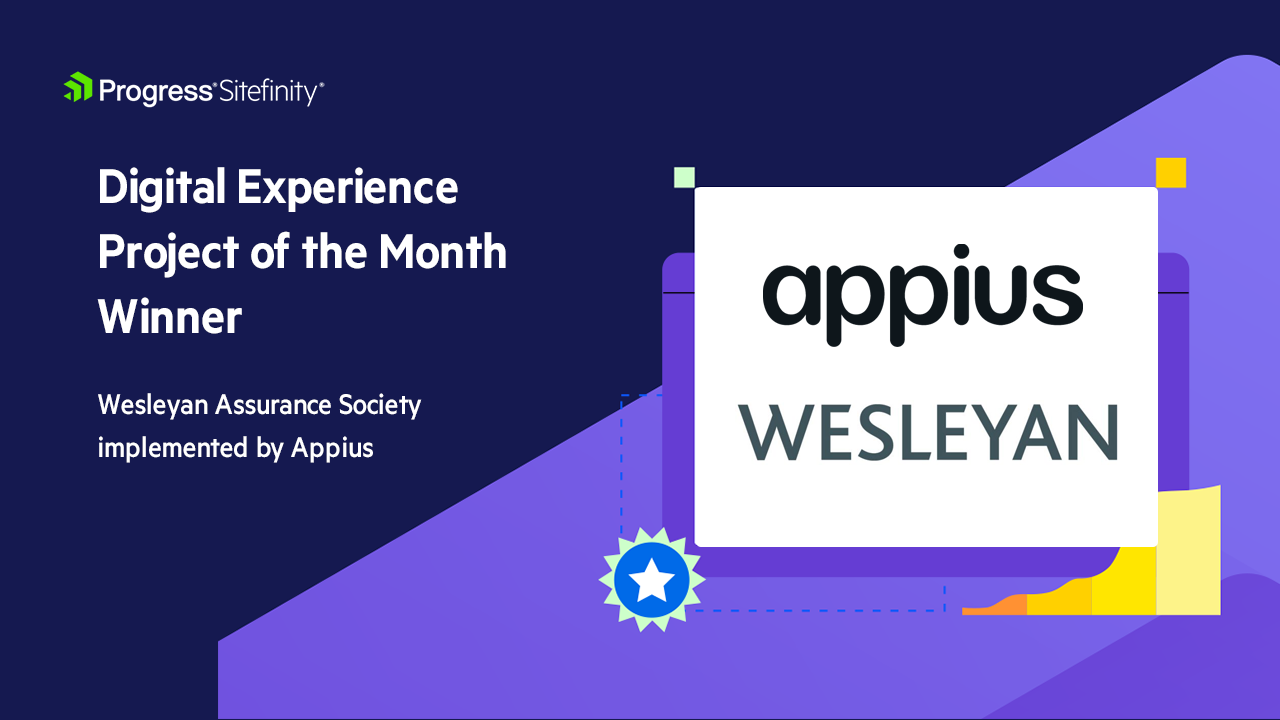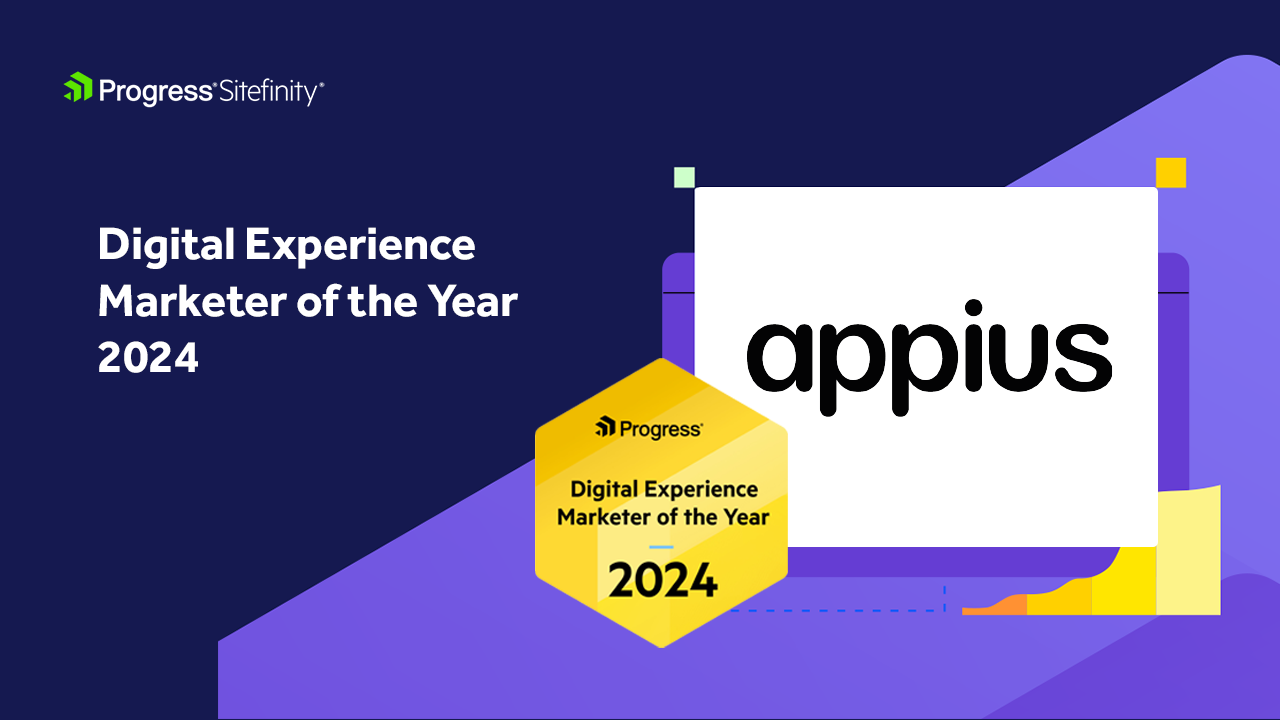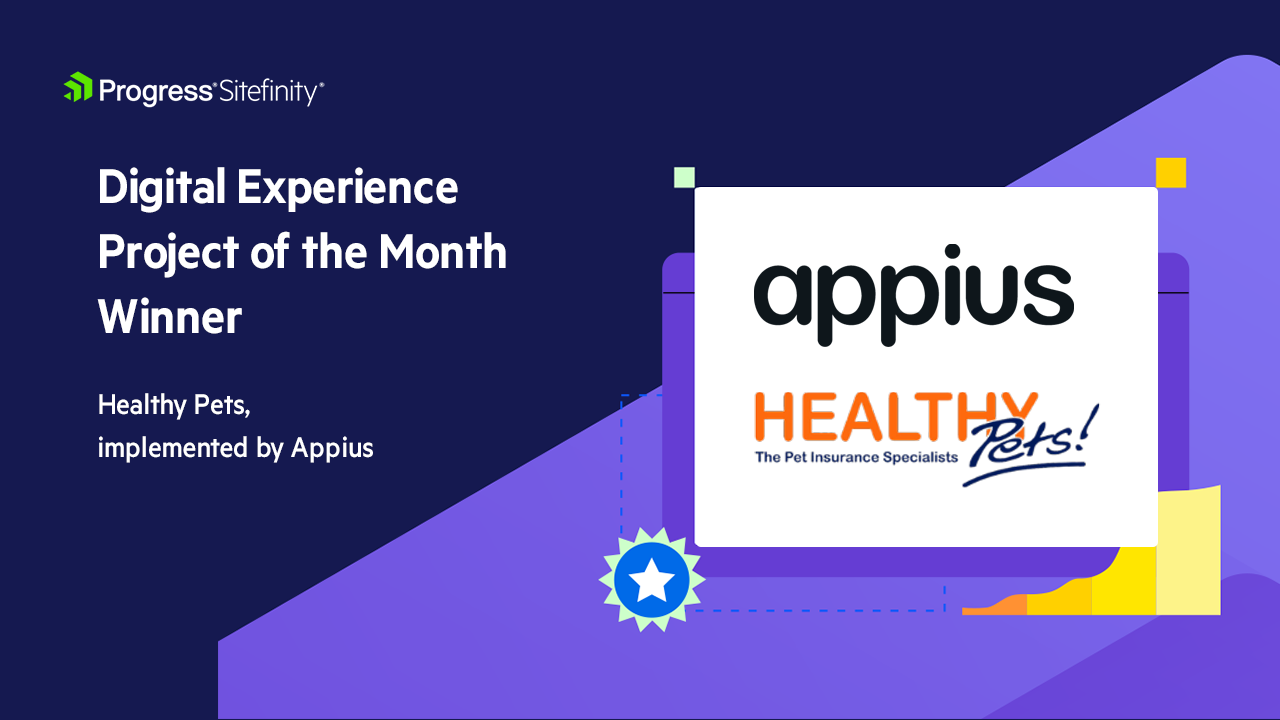Spring is here, and we’re already bracing for another digital shake-up. On June 28th, the European Accessibility Act (EAA) becomes enforceable for even more businesses operating within Europe.
Yep – it doesn’t matter where you’re based. If you offer products or services across Europe, you need to focus on EAA now. This law ensures that all products and services are accessible to people with disabilities, opening up industries that were previously difficult to access.
Alongside physical products and services like public transport, ATMs, and banking information, the EAA also covers digital platforms—including websites and apps across the EU market. If your site serves European users—even indirectly—you’ll need to take note.
Curious how the world’s most prestigious hotel chains are handling the change? Some are nailing it with sleek, compliant designs—while others fall surprisingly short. We’ll spotlight the standouts (and the slip-ups) later on to show what luxe accessibility really looks like in practice.
For some, "accessibility compliance" might recall stripped-back, lifeless websites that lack personality or flair. But here’s the truth: AA accessibility and high-end design can (and should) work together.
In this article, we explore how luxe websites can meet EAA regulations while maintaining their signature style because accessibility isn’t just a local compliance issue; it’s a global design imperative.
We’ll explain why accessibility is the smart move even if you don’t operate in Europe and highlight brands that are already going above and beyond to create seamless, inclusive experiences. But first, what exactly is the European Accessibility Act?
What is the EAA (European Accessibility Act)?
The European Accessibility Act aims to remove barriers, opening an array of digital products and services to everyone. The World Health Organization estimates that 135 million people in Europe live with a disability. The EAA define a person with a disability as:
“An individual with a long-term physical, mental, intellectual, or sensory impairment that prevent them from full, effective, and equal societal participation due to barriers to accessing products and services. They also include elderly people under this definition.”
Complying with the EAA helps create a more inclusive digital experience for all users. The new legislation will impact brands offering services to European users, regardless of location. At its core, the act is built on four key principles—known as the POUR principles:
- Perceivable: Content and interface elements must be presented in ways that users can perceive.
- Operable: Users must be able to interact with all interface elements and navigate the site.
- Understandable: Information and interface functionality must be easy to understand.
- Robust: Content must work reliably across a wide range of devices and assistive technologies.
In the UK, public sector websites and apps must already meet WCAG 2.2 AA standards. From June 2025, all businesses regardless of sector must follow the EAA’s POUR principles If your site serves European users. Non-compliance could lead to penalties, including fines.
EAA Compliance in High-End Design
When you think of luxe brand websites, you picture high-end design—meticulously curated to build lifestyle aspirations. Luxury should feel like luxury.
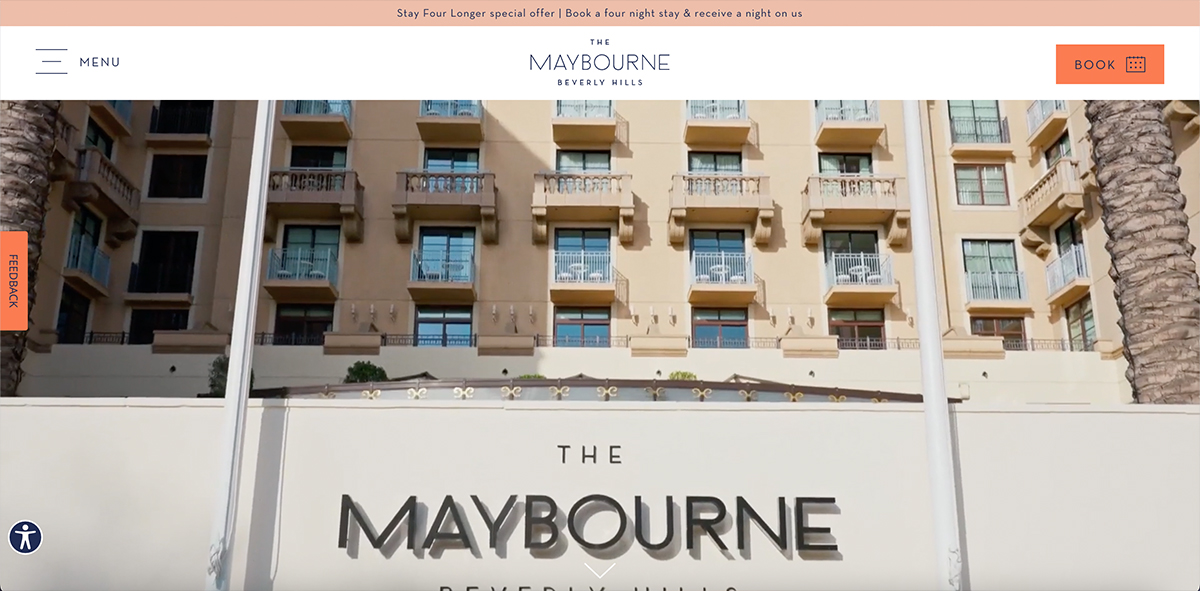
To create that premium experience, designers use a mix of refined typography, custom imagery, responsive layouts, and a well-balanced use of rich colours and white space. Consistent branding and seamless user journeys are essential. Every detail is crafted to deliver a sense of exclusivity and sophistication.
But with so much emphasis on colour, typography, layout, and imagery, is it possible to follow accessibility best practices without compromising on design? With the EAA’s impact affecting everyone that operates in Europe, now is the time for luxury brands to rethink their approach and lead in both design and accessibility.
The EAA challenges brands and designers to be more intentional. These requirements don’t restrict creativity—they elevate it.
Global Accessibility Compliance: Beyond the UK
While the EAA mandates accessibility for digital platforms operating across Europe, it's important to recognise that similar regulations exist in other parts of the world. For instance, California's Assembly Bill 1757 (AB 1757) requires all websites and mobile applications accessed in California to comply with the Web Content Accessibility Guidelines (WCAG) 2.1 Level AA standards. This legislation not only imposes legal obligations on businesses but also allows individuals to sue for statutory damages if they encounter accessibility barriers.
These developments signal a global shift towards stricter digital accessibility standards, making it imperative for luxury brands worldwide to prioritize compliance. Whether you're operating in Europe, the U.S., or beyond, accessible design isn't just a trend it's an expectation that spans borders.
EAA: Inspiring Better Website Design
With a shift towards user inclusion, and accessibility being at the heart moving forward, here’s how accessibility can inspire better luxury design:
- Rethink the luxury experience for all users: Ensure that every user, regardless of ability, can access and engage with your site in a way that feels just as premium.
- Innovate with colour, contrast, and typography: Use design elements creatively to maintain elegance while enhancing legibility and user interaction.
- Create immersive, non-visual experiences: Build a rich, sensory experience that doesn’t rely solely on visuals, making it accessible for those with various disabilities.
- Embrace inclusive innovation: Ensure that all users feel seen, welcomed, and valued—making your brand stand out as a forward-thinking, inclusive leader in luxury.
With thoughtful design, luxe websites can not only meet the POUR principles but do so without sacrificing their elegance or premium feel.
How Luxe Brand Sites are Implementing the POUR Principles
Designing a beautiful website is just the start. The real challenge lies in user experience making sure everyone, regardless of ability, can access and engage with your content.
As we've discussed, the EAA guidelines and POUR principles encourage designers to push boundaries. The best digital teams know how to create a luxe feel that’s also Perceivable, Operable, Understandable, and Robust.
Here’s how some luxury brands are approaching each principle:
EAA Guidelines: Perceivable
When designing a luxury website that follows WCAG 2.2 AA guidelines, one key truth stands out: not everyone experiences your site the same way. The content on each page must be perceivable to all users regardless of how they access it.
Take The Ritz, for example. Their website has an accessibility score of 76 out of 100, with points lost for key errors that prevent some users from accessing important elements.
A major issue? Missing alt text on images. Without it, screen readers can’t describe visuals to users with impaired vision, which significantly limits their experience.
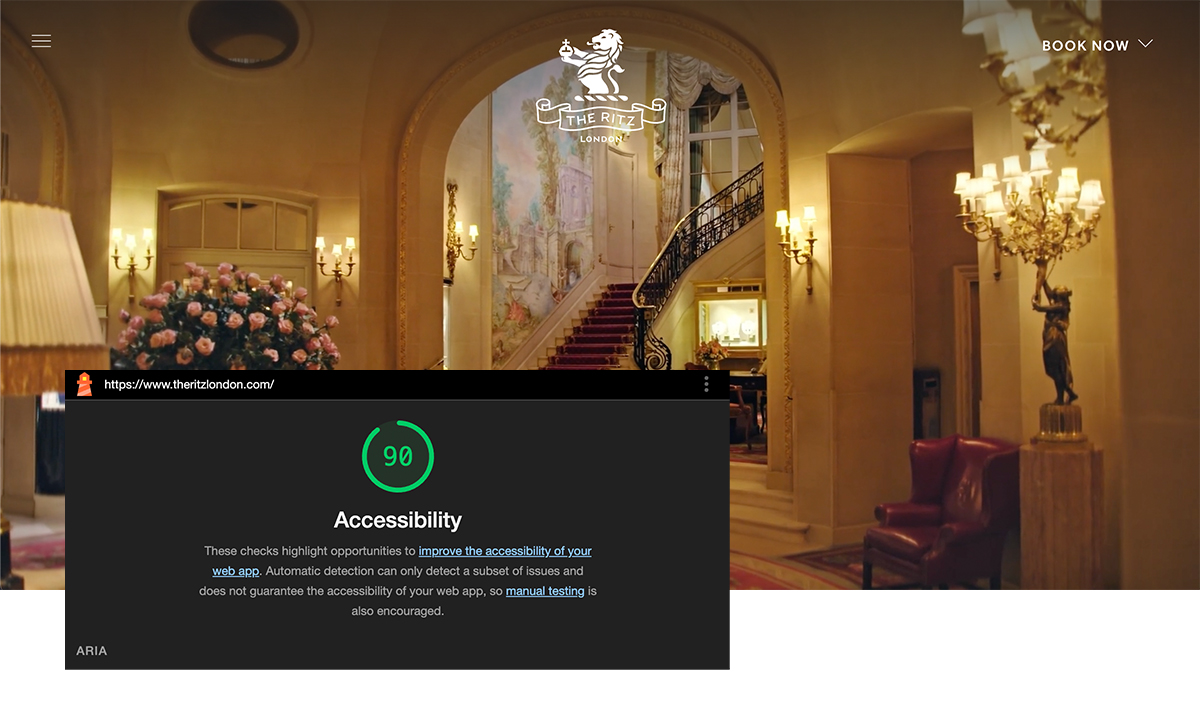
High-end websites rely on custom imagery and beautiful typography—and they can still do so while being accessible. Simple additions, like ARIA tags, help screen readers interpret the page properly. Here are more ways to ensure your luxury website is perceivable under EAA guidelines:
- Add descriptive alt text to all images (or mark purely decorative images appropriately).
- Use proper semantic HTML for lists (<ul>, <ol>, or <menu>) so screen readers can navigate them.
- Use aria-label to provide clear labels for elements, especially when visual cues aren’t enough.
- Include the lang attribute in the HTML to ensure screen readers pronounce text correctly.
- Avoid using aria-hidden="true" on important content, as this hides it from assistive technologies.
- Avoid using the [aria-hidden=”true”] attribute to hide page elements from screen readers and assistive technology.
EAA Guidelines: Operable
Once users can perceive the information, the next step is ensuring the website is operable. For luxe brand sites, this often means offering features like booking platforms, shopping experiences, or form submissions. An operable website allows all users to interact with every element, regardless of assistive technologies or disabilities.
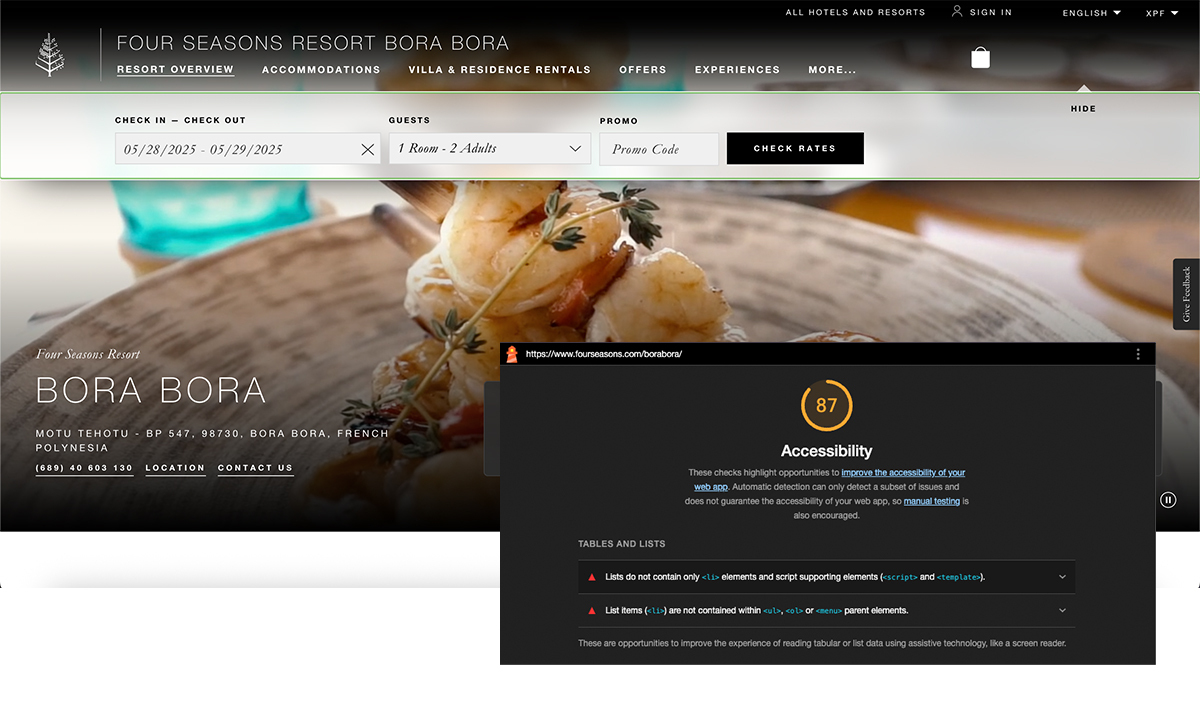
While the Four Seasons Bora Bora has a decent accessibility score of 87, it misses key accessibility practices. The primary issue is that some touch targets (buttons and links) are too small or spaced too closely, making them difficult to use for people with mobility impairments.
Here are some other common accessibility challenges for designing operable luxe sites:
- Ensure touch targets, such as links and buttons, have sufficient size and spacing.
- Maintain a high contrast ratio between background and foreground colours.
- Buttons should have accessible labels, preventing screen readers from simply announcing them as “button.”
- Use ARIA attributes to help screen readers understand when elements are expanded, collapsed, or have selectable options.
- Associate form elements with clear labels so assistive technologies can announce them accurately.
EAA Guidelines: Understandable
It's important to remember that screen readers interpret and process information differently than sighted users. For instance, using a large, bold font to highlight key information might work for sighted users, but it won’t help screen readers differentiate this from the rest of the text.
Capella Bangkok, a luxury resort in Thailand, offers a prime example. The hotel’s website presents various sections like location, dining options, awards, and room types, but it lacks proper use of heading tags. As a result, a screen reader might struggle to navigate through the content effectively.
To improve accessibility in this area, designers must ensure that the page layout and structure are clear both visually and for assistive technologies. Here are some strategies to enhance understanding:
- Use heading elements (H1, H2, H3, etc.) in a clear, sequential order.
- Include alt tags for all infographics to describe the information they convey.
- Add captions to videos (captions are more descriptive than subtitles, as they include all audio elements).
- Use the [aria-describedby] attribute to provide added context for elements.
EAA Guidelines: Robust
Robustness refers to a site’s compatibility with a wide range of users and technologies, including assistive tools. When a website follows the POUR principles, it is more likely to pass this test, especially with responsive design.
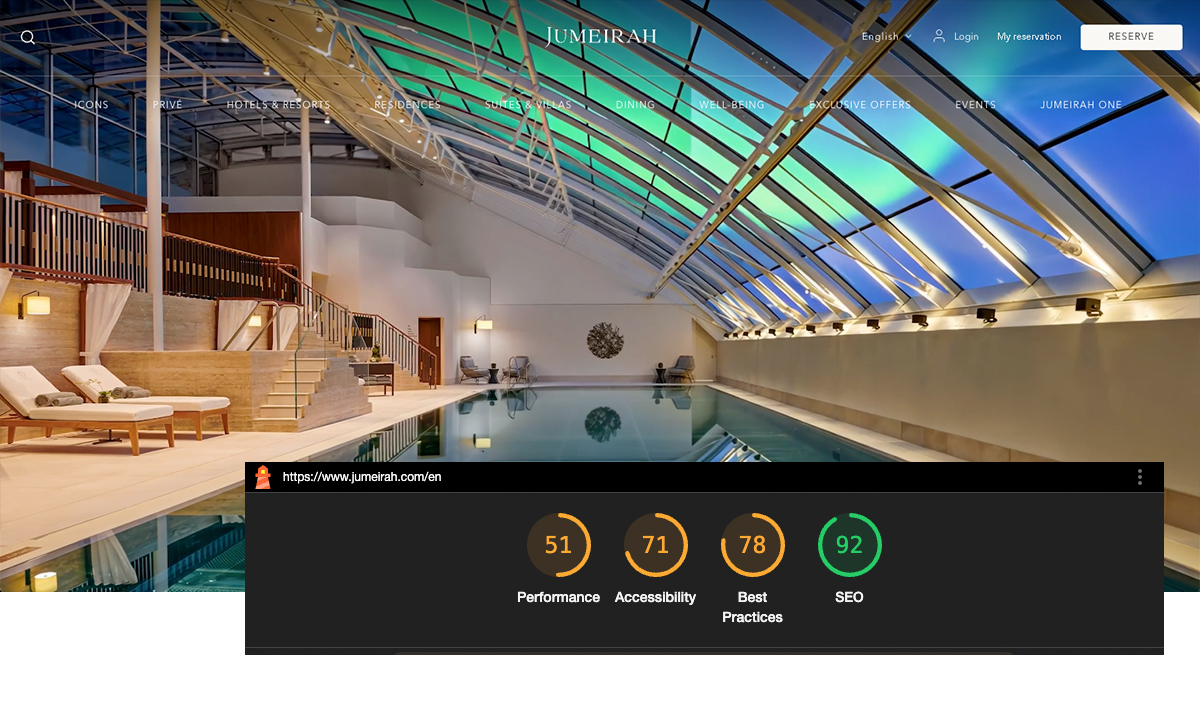
However, not all sites prioritise Core Web Vitals, which can affect accessibility. For instance, Jumeirah's site has a Cumulative Layout Shift (CLS) score of 0.435 and takes more than a second to load its First Contentful Paint (FCP). Pages that load slowly or shift elements during the loading process make it harder for assistive technology to interpret the content correctly.
Here are some strategies to ensure robustness:
- Check Core Web Vitals to ensure pages load quickly, and there is no cumulative layout shift.
- Use responsive design that adjusts to various screen sizes without affecting the content hierarchy.
- Provide discernible text for input buttons, so screen readers can identify their purpose.
Accessible Luxe Site Design: Is It Possible?
Making your website accessible to every user is no longer just a business decision. Starting in June 2025, all brands operating in Europe must comply with the EAA guidelines. We’ve highlighted some luxe brand sites that don’t quite meet accessibility standards but the real question is: Is it even possible to create a luxe site that’s also accessible?
The answer is yes.
The Maybourne: Luxe Meets Compliance
The Maybourne Beverly Hills exudes sophistication, with rooms starting at around $600 per night. The website captures the essence of the hotel experience through stunning video heroes, custom luxury imagery, and smooth transitions that echo the venue’s elegant atmosphere.
What makes the Maybourne website stand out is how effortlessly it blends high-end design with accessibility. The carefully chosen colour scheme sunset orange, navy blue, greys, and pastels adds to the luxurious feel while ensuring a strong contrast for readability on all devices. Responsive design ensures the site looks and works beautifully, no matter what device visitors use.
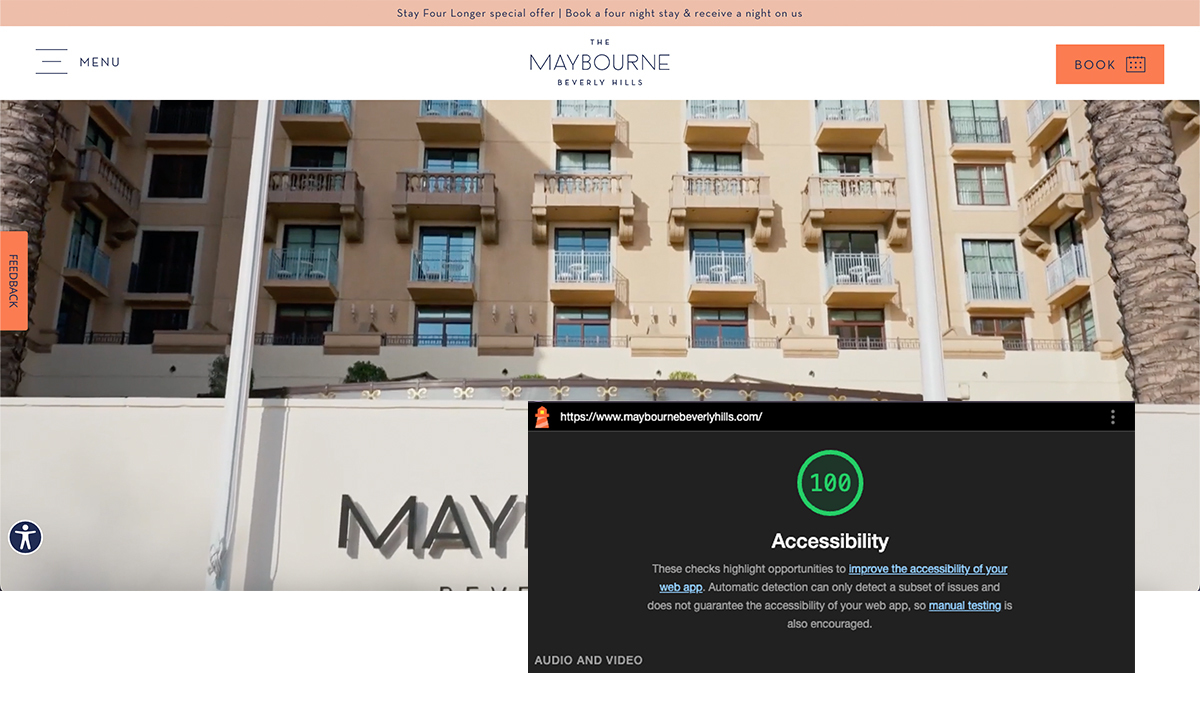
With a perfect accessibility score of 100/100, the Maybourne website proves that accessibility and luxury can coexist without compromise. Some of the features that contribute to this include:
- Easy Navigation: ARIA labels help users with screen readers easily move through the site, ensuring they don’t miss out on any key information.
- Descriptive Images: Alt text is used thoughtfully, making sure all images, even those with intricate design details, are accessible to those with visual impairments.
- Speed and Stability: The site loads quickly and doesn’t have any layout shifts, offering a smooth and stable experience for everyone.
- Inclusive Interaction: Touch targets, like buttons and links, are appropriately sized and spaced for users with mobility impairments.
One area that’s often overlooked in accessibility audits is PDFs. Many site owners either forget they exist or assume they’re invisible to Google - but that’s not the case. If your luxe website includes downloadable or embedded PDFs, these must also meet EAA requirements.
Just like your web pages, PDFs should follow core accessibility principles: use high contrast for text, add descriptive alt text for images, apply clear metadata, and structure content with properly ordered heading levels. Crucially, all interactive elements within the PDF must be fully operable using a keyboard alone, so users relying on screen readers can navigate without needing a mouse.
By following the POUR principles while keeping the brand’s luxurious identity front and centre, the Maybourne site delivers an experience that’s both accessible and sophisticated. It’s a great example of how high-end design can be inclusive and user-friendly, meeting the European Accessibility Act requirements without compromising on style.
Why You Should Prioritise Accessibility Now
As we approach June 2025, making your website accessible isn’t just a compliance issue it’s an opportunity. The European Accessibility Act (EAA) will soon apply to all brands operating in Europe, and while the legislation is a step toward inclusivity, it also brings with it significant benefits for businesses that prioritise accessibility.
Here’s why accessibility matters:
Competitive Advantage & Innovation
Inclusive design drives innovation. Companies that embrace diverse perspectives are more likely to make better decisions and adapt to change quickly. By designing websites that are accessible to everyone, you’re not just meeting legal requirements; you’re leading the way in customer-first thinking and setting yourself apart from the competition.
Financial & Brand Benefits
Accessible websites aren’t just good for users they’re also good for your bottom line. Strong ESG (Environmental, Social, and Governance) performance enhances your brand reputation, operational efficiency, and investor appeal. Accessibility signals to stakeholders that your business is responsible, forward-thinking, and committed to making a positive impact.
Market & Talent Opportunity
The global spending power of people with disabilities and their families is an estimated $8 trillion. By excluding this demographic, businesses miss out on a significant market. Accessible websites ensure you don’t leave anyone behind, whether they’re consumers or potential employees.
In fact, many users with disabilities are loyal to brands that cater to their needs. The same goes for talent—the more inclusive your website, the more likely you are to attract a diverse workforce.
Future-Proofing Your Business
Compliance with the EAA ensures your website is future-proof. Digital accessibility isn’t just a trend it’s becoming a global standard. As more countries adopt similar legislation, brands that invest in accessibility now will be ready for any upcoming regulations.
Enhanced User Experience
Accessibility doesn’t just benefit people with disabilities; it improves the experience for everyone. Clear navigation, faster load times, and consistent design make your website more usable for all visitors. As users expect a more intuitive and seamless online experience, accessible websites are becoming the norm, not the exception.
Summary
With the European Accessibility Act (EAA) becoming enforceable in June 2025, luxury brands must adapt their websites to be accessible to all users, including those with disabilities. The EAA introduces the POUR principles (Perceivable, Operable, Understandable, Robust) to ensure websites are inclusive.
While luxury sites are known for their high-end design, they can also meet accessibility standards by thoughtfully incorporating colour, typography, and navigation that work for everyone. Brands like Maybourne demonstrate that it’s possible to combine luxury design with accessibility, offering a seamless user experience without compromising style.
Prioritising accessibility not only ensures compliance but also brings competitive advantages, financial benefits, and market opportunities. As digital accessibility becomes a global standard, brands that embrace inclusive design will lead the way in innovation, attracting both loyal customers and top talent.
Ready for Your EAA Upgrade?
Our experts design and develop luxury sites according to the WCAG 2.2 AA guidelines, ensuring content is available to everyone.
Whether you’re looking for a fresh look that meets EAA legislation or need some user experience guidance to ensure your current brand site is compliant, get in touch with Appius today.
Trust me, it’s not as scary as you’d think…
* Disclaimer: The assessments of accessibility level mentioned in this blog are only indicative using Google Lighthouse accessibility score. Fuller investigations and tests would be required to confirm any particular WCAG levels of accessibility.
About Author

Before Appius Nic was formally trained with a degree in Animation Production from the Arts University Bournemouth. She then has moved across a number of creative industries including garment printing, vehicle signage and print materials. After joining Appius in 2019 she fully embraced the UX designer identity that has now become the norm, and becoming an expert practitioner in all of the areas described above. Nic can make your brand and user journeys come to life across multiple channels and is a key player in a number of aspects of what makes Appius special.

